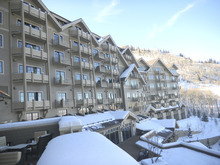This is an archived article that was published on sltrib.com in 2012, and information in the article may be outdated. It is provided only for personal research purposes and may not be reprinted.
At long last, winter's belated arrival helped lift bookings out of the doldrums at mountain resorts in Utah and other Western states.
The Denver-based Rocky Mountain Lodging Report said Monday that lodging establishments it monitors in Park City and other Utah ski destinations filled almost 71 percent of their rooms in February. That was up from 67 percent a year earlier and 59 percent in February 2010.
Long-awaited snowfall boosted those numbers, said another group out of Denver, the Mountain Travel Research Program, based on data from 265 property-management companies overseeing 24,000 rooms in 15 resort communities in Utah, Colorado, California and Oregon.
"Reservations taken in February for arrival in February were up 6.2 percent compared to the same month last year," said Research Program Director Ralf Garrison.
"Despite uncooperative weather patterns and the third warmest winter in the U.S.'s recorded history, skiers and riders still tracked the snow, and lodging rates and showed up when the snow flew," he added. "Although overnight lodging occupancy was down slightly for the month, it was better than we feared, in some cases offset by surprising strength in rate."
Garrison's research showed that occupancy last month in those four Western states ended up 2 percent below the level for February 2011. Hoteliers and property managers made up for some of that deficit, bumping up the average daily rate 2.7 percent.
In Utah, February's average daily rate climbed to $249, up about $4 from the previous year. The figure most important to the lodging industry, Revpar, or revenue available per room, climbed to $176 per day from $158 daily in February 2011, according to the monthly Rocky Mountain Lodging Report.
Although conditions improved considerably in February, Garrison's report found that bookings for March remained almost 4 percent behind the same month a year earlier, with daily rates up only 1.1 percent.
Rising gas prices are a concern, Garrison said, but he found some comfort in the fact that for the first time since the Great Recession began in late 2007, weather was more important than the economy in influencing the resort industry's health.
"Decent weather returned mid-season to help generate some additional late-season demand, but not enough for a full recovery in most cases," he said. "Despite the challenges, many mountain destinations seem to have done a good job managing 'the hand they were dealt' by controlling the elements they could — slope maintenance and attention to guest services."
Whether they did that well enough to maintain customer loyalty, Garrison said, will be determined in coming months when people begin making reservations for next winter.
Elsewhere in Utah, the Rocky Mountain Lodging Report said occupancy statewide during February was 65 percent, up from 63 percent a year earlier, with the cost of a room climbing $5 nightly to $111.
In Salt Lake County, hoteliers filled 74 percent of their rooms nightly last month, a 4 percent jump from the previous February. On average, rooms went for $99 a night, up from $92 a year earlier.
Twitter: @sltribmikeg





